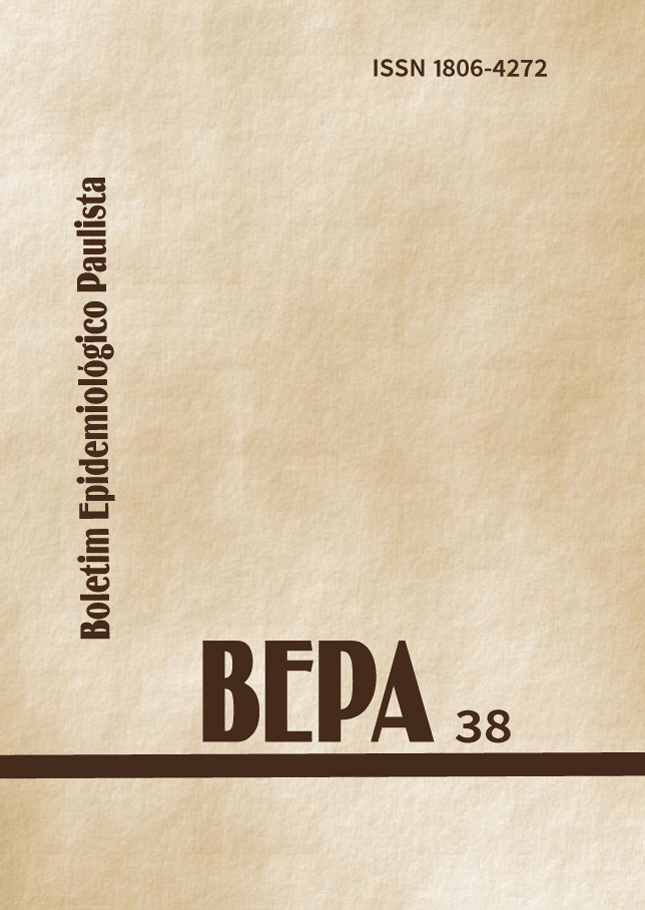Abstract
Foodborne botulism is a severe neuroparalytic disease caused by the ingestion of food containing preformed Clostridium botulinun neurotoxin. In Brazil, reported cases of botulism have been usually caused by toxin type A related with canned vegetable, fruits or meat, in generally, homemade products. We report the findings of the botulism case investigation that occurred in january 2007, in the city of São Paulo (SP), caused by the ingestion of commercial chicken pie with hearts of palm and peas. Type A and B toxin were detected in a serum sample from the patient and in the suspected food. Based on clinical features and additional electromyography findings, therapeutic antitoxin was promptly administrated to the patient. Educational and sanitary measures were developed to prevent new cases.
References
Coordenadoria de Controle de Doenças. Centro de Vigilância Epidemiológica “Prof. Alexandre Vranjac”. Divisão de Doenças de Transmissão Hídrica e Alimentar. Manual de Botulismo – Orientações para Profissionais de Saúde. São Paulo: Secretaria de Estado da Saúde 2002.
Cecchini E, Ayala SEG, Coscina Neto AL, Ferrareto AMC. Botulismo. In: Veronesi R, Focaccia R, editores. Tratado de Infectologia. 1ª ed. São Paulo: Atheneu 1997; p. 565-74.
Cherington M. Botulism: update and review. Seminars in Neurology. 2004, 24(2): 155-163.
Ministério da Saúde. Secretaria de Vigilância em Saúde. Guia de Vigilância Epidemiológica 2005. Brasília, DF. 6ª edição.
Benenson AS (editor). Control of Communicable Diseases Manual.16th ed. Washington: American Public Health Association 1995.
Sobel J, Tucker N, Sulka A, McLaughlin J, Maslanka S. Foodborne botulism in the United States, 1990–2000. Emerg Infect Dis [serial on the Internet]. 2004 Sep [acessado em 1/2/07]. Disponível em: http://www.cdc.gov/ncidod/EID/vol10no9/03-0745.htm.
Brett M. Botulismo no Reino Unido. Euro Surveill 1999;4(1):9-1.
Centers for Disease Control and Prevention. Botulism Associated with Commercial Carrot Juice – Georgia and Florida, September 2006. MMWR 2006; 55(40):1098-9.
Angulo F, Getz J, Taylor JP, Hendricks KA, Hateway CL, Barth SS, Solomon HM, Larson AE, Johnson EA, Nickey LN, Ries AA. A large outbreak of Botulism: the hazardous baked potato. JID 1998; 178:172-7.
Coordenadoria de Controle de Doenças. Centro de Vigilância Epidemiológica “Prof. AlexandreVranjac”. Divisão de Doenças de Transmissão Hídrica e Alimentar. Botulismo e torta comercial de frango com requeijão. BEPA 2006; (27):14-19. Disponível em: http://www.cve.saude.sp.gov. br/agencia/bepa27_botu.htm.
Centers for Disease Control and Prevention. Botulism in United States, 1899-1996, handbook for epidemiologists, clinicians and laboratory workers. Atlanta: The Centers 1998.
Centers for Disease Control and Prevention. Botulism and Commercial Pot Pie, California. MMWR 1983; 352(3):39-40.
Angulo FJ, St. Louis ME. Botulism. In: Centers for Disease Control and Prevention (CDC). Bacterial Infections of Humans – Epidemiology and Control. Atlanta: The Centers 1999. p 139-153.
Giménez DF, Ciccarelli AS. Another type of Clostridium botulinum. Abl. Bakt. I Abt. Orig. 1970; 215:221 -224
Lindström, M & Korkeala, H. Laboratory Diagnostic of Botulism. Clinica, Microbiology Reviews 2006, 19(2): 298-314.
Woodruff BA, Griffin PM, McCroskey LM, Smart JF, Wainwright RB, Bryant RG, Hutwagner LC, Hatheway CL. Clinical and laboratory comparison of botulism from toxin types A, B and E in the United States, 1975-1988. JID 1992;166:1281-6.
Coordenadoria de Controle de Doenças. Centro de Vigilância Epidemiológica “Prof. Alexandre Vranjac”. Divisão de Doenças de Transmissão Hídrica e Alimentar. Botulismo – Estado de São Paulo e Brasil: casos suspeitos e confirmados notificados ao Centro de Referência do Botulismo – CR BOT, 1999-2006. [Dados estatísticos on-line]. Disponível em: http://www.cve.saude.sp.gov.br/htm/hidrica/ dados/botulismo05_dados.ppt.
Eduardo MBP, Sikusawa S. O botulismo no Estado de São Paulo – Construindo uma série histórica e documentando os casos, de 1979 a 2001. Rev Net DTA 2002; 2(4):51-67. Disponível em: ftp://ftpcve.saude.sp.gov.br/doc_tec/hidrica/revpo2_vol2n4.pdf.
Figueiredo MAA, Dias J, Lucena R. Considerações acerca de dois casos de botulismo ocorridos no Estado da Bahia. Rev Soc Bras Med Trop 2006; 39(3):289-291.
Coordenadoria de Controle de Doenças. Centro de Vigilância Epidemiológica. Divisão de Doenças de Transmissão Hídrica e Alimentar. Investigação de surto de botulismo associado a tofu (queijo de soja), no município de São Paulo, dezembro de 2005. BEPA 2006. Disponível em: http://www.cve.saude. sp.gov.br/agencia/bepa25_botu.htm.
Solomon HM, Johnson EA, Bernard DT, Arnon SS, Ferreira JL. Clostridium botulinum and its toxins. In: Downes FP, Ito K. Compendium of Methods for the Microbiological Examination of Foods. 4th ed. Washington, DC: APHA 2001. p. 317-324.

This work is licensed under a Creative Commons Attribution 4.0 International License.
Copyright (c) 2007 Maria Bernadete de Paula Eduardo, Geraldine Madalosso, Olga Ribas Paiva, Sheila do Nascimento Brito, Evanise Segala Araújo, Claudete Regina Sanchez Bandeira, Ruth E. G. Rowlands, Christiane Asturiano Ristori, Mioko Jakabi
